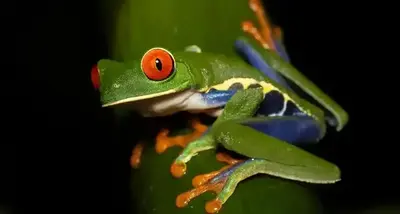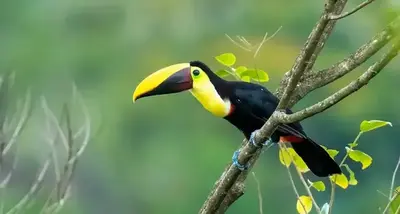Costa Rican Amphibian Research Center
Ecolodge & Guayacán Rainforest Reserve
- 121 acres (49 hectares) protected primary & secondary rainforest
- 3 km trails all to yourself. 24 hour access for visitors
- Guided tours available
- Greatest amphibian biodiversity in Costa Rica
- Best place in the world to see Agalychnis lemur
Table of Contents
Costa Rican Amphibian Research Center (CRARC)
Welcome to the Costa Rican Amphibian Research Center (CRARC), Costa Rica’s perfect ecolodge for those with a passion for herping, birding, and wildlife photography. Protecting 121 acres of pristine rainforest, CRARC offers unparalleled access to one of Costa Rica's most biodiverse habitats. With only one guest lodge on the property, you’ll have the entire property, and 3 km of trails all to yourself, enjoying unrestricted exploration day and night! Guided tours are available for those who seek herpetologist’s Brian Kubicki’s expert insights, and uncanny ability to find elusive nocturnal herps. Alternatively you can choose to wander the wild trails independently, immersing yourself in the natural beauty of the primary rainforest.
About the Costa Rican Amphibian Research Center (CRARC)

The Costa Rican Amphibian Research Center (CRARC) is a remarkable ecological initiative founded by Brian Kubicki in 2002. His deep-rooted passion for amphibians and unwavering commitment to environmental conservation have driven the center’s mission. Brian, who has been conducting amphibian research in Costa Rica since 1998, created CRARC to focus on the study and preservation of amphibians while pioneering innovative conservation methods in one of the world’s most biodiverse regions. Through extensive fieldwork, Brian has contributed to the discovery and documentation of numerous amphibian species, including several new to science. His dedication extends to restoring natural habitats, ensuring that future generations of both wildlife and visitors can benefit from this exceptional reserve.
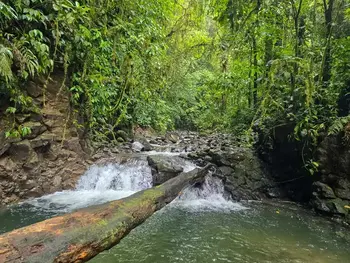
One of the most significant achievements of CRARC is the preservation of the Guayacán Rainforest Reserve. Encompassing 121 acres of tropical rainforest, the reserve is situated in the central Caribbean foothills of Costa Rica, an area renowned for its incredible biological diversity. The land was originally purchased in 2002 for the purpose of conserving this biodiverse habitat of primary, secondary and recovering rainforest, and to protect it from deforestation for ranching and from human encroachment. The conservation efforts not only protect amphibians but also support the survival of a diverse array of other wildlife, from invertebrates to reptiles, amphibians, mammals, birds, and all the flora and fauna that rely on this pristine and biologically intense environment.
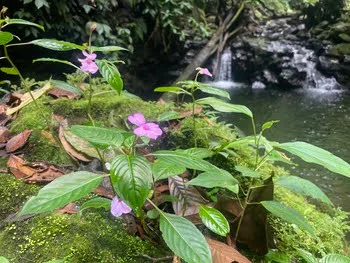
Nature enthusiasts will be overwhelmed with the staggering biodiversity and the unparalleled experience CRARC offers. The reserve's strategic location on the Siquirres River watershed creates a unique microclimate that fosters an abundance of life, making it one of the richest amphibian habitats in the country. Visitors to the reserve can expect to encounter an extraordinary variety of species, including over 70 documented amphibian species, with particular highlights being the glass frogs and poison frogs that thrive in the area. This biodiversity is due in part to the reserve’s representation of two life zones: Tropical Wet Forest and Tropical Premontane Rainforest, which together support a rich overlap of lowland and mid-elevation species.
The amphibians, such as dart frogs and the iconic red eyed tree frog, are not the only draw for visitors. Reptiles, especially snakes are frequently spotted, alongside mammals such as ocelots, two-toed and three-toed sloths, and howler and capuchin monkeys. Birders will delight in the more than 200 bird species that have been observed within the reserve, including frequent sightings of toucans and parrots, making CRARC an excellent destination for wildlife photographers looking to capture the beauty of Costa Rica’s diverse fauna. The reserve’s wild and unspoiled nature provides countless opportunities to witness animals in their natural habitats, whether on a guided tour or exploring independently, CRARC's old growth primary forests offers explorers the quintessential tropical rainforest experience.
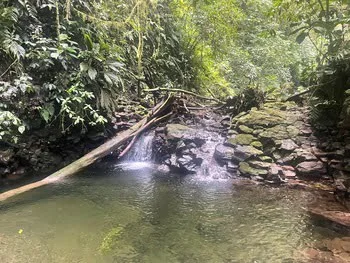
One of the standout features of CRARC is its exclusivity. The ecolodge offers visitors private access to the reserve, ensuring that each group has the property entirely to themselves. This unique setup allows guests to fully immerse themselves in the natural rainforest surroundings without the presence of other tourists. The lodge offers comfortable accommodations, and visitors can explore the reserve at their own pace, both day and night, with few restrictions. Whether you are a seasoned herper, an avid birder, or simply seeking solitude in nature, the CRARC provides a serene, undisturbed environment to connect with the rainforest’s vibrant ecosystems.
View A Partial Checklist of Amphibians Recorded at CRARC →The Costa Rican Amphibian Research Center is much more than just an ecolodge—it's a living testament to the importance of conservation and biodiversity. Brian Kubicki's work, supported by his family and a global network of scientists and enthusiasts, continues to make significant contributions to the understanding and protection of amphibians. By visiting CRARC, guests not only enjoy an unforgettable experience in one of the most biodiverse regions in the world but also support critical conservation efforts that ensure the survival of these species for generations to come. Visiting CRARC provides economic support to Brian's pioneering conservation efforts and provides economic incentive for other entrepreneurial conservationists to do the same.
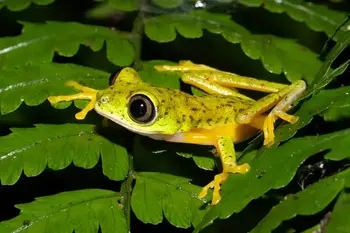
Lemur Leaf Frog: Back from the Edge of Extinction
The Lemur Leaf Frog (Agalychnis lemur) was once a common sight in Costa Rica, but habitat loss and the deadly fungal disease chytridiomycosis caused a drastic 80% population decline within just a decade. By the early 2000s, the species had become critically endangered, with only two known populations remaining in Costa Rica and a disjunct Panama population. Recognizing the urgency of this situation, Brian Kubicki initiated an innovative in situ conservation project in 2003 at the Costa Rican Amphibian Research Center (CRARC). His goal was to re-establish a breeding population of the Lemur Leaf Frog within the Guayacán Rainforest Reserve. Kubicki and his team created artificial and semi-natural breeding ponds throughout the reserve, ranging from small 1-2 meter ponds to strategically placed plastic tubs and barrels. Tadpoles were introduced to these breeding sites, with the hope that they would thrive in the protected environment.

The project proved to be a resounding success. Within a year, breeding adults were regularly observed around the newly created ponds. In 2005, additional breeding tubs were placed in a separate section of the reserve, further expanding the frog’s habitat. The success of this effort was not limited to the CRARC reserve alone; the Lemur Leaf Frog population began to expand into neighboring forest areas where the species had not been previously documented. Today, visitors to the reserve can often spot these vibrant frogs among the vegetation, a testament to the effectiveness of Kubicki’s conservation efforts. Thanks to this groundbreaking project, the Lemur Leaf Frog, once on the brink of extinction, now thrives in one of its last strongholds in Costa Rica.
View A Partial Checklist of Reptiles Recorded at CRARC →Birding CRARC

CRARC may be best known for amphibians, but it's also a hidden gem for bird photographers—especially those after toucans. Both keel-billed and yellow-throated toucans are unusually abundant here and frequently perch at eye level, offering outstanding photo opportunities. A cleared hilltop on the property overlooks a steep dropoff into the canopy below, letting you scan for birds from above and capture treetop-level shots. Other common species include Montezuma oropendolas, red-rumped tanagers, hummingbirds and aracaris, all of which are common around the guest house, and often seen from the comfort of the porch rocking chairs.
View A Partial Checklist of Birds Recorded at CRARC →Accommodations
-
 Price: $130/night 1 to 2 people. $30 per each additional person per night. Monday night through Thursday night.
Price: $130/night 1 to 2 people. $30 per each additional person per night. Monday night through Thursday night.
-
 Beds: Sleeps up to 7 people in 2 full sized beds, and three twins in two rooms.
Beds: Sleeps up to 7 people in 2 full sized beds, and three twins in two rooms. -
 Check In/Out: Check-in after 3 p.m. day of arrival and before 12:00 noon day of check-out.
Check In/Out: Check-in after 3 p.m. day of arrival and before 12:00 noon day of check-out. -
 Full Kitchen: Fridge/freezer, sink, stove, microwave, coffee maker, dishes, cookware, utensils.
Full Kitchen: Fridge/freezer, sink, stove, microwave, coffee maker, dishes, cookware, utensils.  Ceiling fans. No A.C., but very comfortable indoor climate.
Ceiling fans. No A.C., but very comfortable indoor climate. Gated Property
Gated Property Outlets for Electronics
Outlets for Electronics
 Meals: No meal service provided. Guests use full kitchen or restaurants in nearby Siquirres (10 km away).
Meals: No meal service provided. Guests use full kitchen or restaurants in nearby Siquirres (10 km away). Easy road access. No 4wd required.
Easy road access. No 4wd required. Outdoor Patio and Dining Area.
Outdoor Patio and Dining Area. Bathroom: Shower, sink, toilet, hot & cold water.
Bathroom: Shower, sink, toilet, hot & cold water. Living room with leather couch.
Living room with leather couch. Parking in private driveway.
Parking in private driveway. Laundry: outdoor sink with detergent. Clothes line to dry.
Laundry: outdoor sink with detergent. Clothes line to dry. No wifi. Cell/data service available on site.
No wifi. Cell/data service available on site. Languages Spoken: English, Spanish
Languages Spoken: English, Spanish
CRARC in 360°
Click and drag your mouse on the images below to change the view perspective
360° Swimming Hole at CRARC
Trails of the Costa Rican Amphibian Research Center
The 3km trail system at the Guayacán Rainforest Reserve is open to CRARC guests for foot travel both day and night. These trails are designed to follow the natural contours of the mountainous terrain, making exploration easier while providing access to diverse habitats within the heart of the rainforest. Along the way, you’ll encounter various water sources, including small ponds, streams, and the Siquirres River, offering prime opportunities for wildlife observation.

Your wildlife adventure begins right outside the guest house, where a beautiful garden attracts a variety of creatures. From the comfort of the rocking chairs on the porch, you can hear and see birds such as toucans and parrots in the nearby trees. The garden area is also home to two species of dart frogs, Dendrobates auratus and Oophaga pumilio, which are commonly seen hopping around.
As you head into the rainforest, you'll pass a hilltop that offers a stunning view of the entire reserve and surrounding primary rainforest before descending to the Ilex Stream. This spot, at eye level with the treetops, is ideal for observing birds and obtaining those coveted eye-level bird shots. Once you cross the stream, you'll have access to 3km of well-maintained trails and additional terrain along the Siquirres River, providing easy and safe exploration of the rich rainforest.
Contact Brian for detailed information of the trails and trail maps.
Night Tours of Guayacán Rainforest Reserve
While unguided hiking in the reserve is allowed, day or night, booking a night tour with Brian Kubicki is the best way to maximize your chances of spotting amphibians. Brian’s expert knowledge of the reserve and his keen eye for finding even the most elusive species make his guided tours the best way to maximize your wildlife sightings.
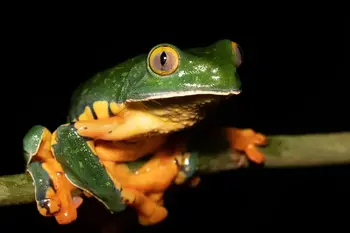
Brian offers four different tours, each varying in difficulty and duration. Prices correspond to the length of the tour, with more extended tours offering more opportunities for sightings. The easiest option is a 1 to 1.5-hour tour of the garden area. The next tour, lasting about 2.5 hours, provides the chance to see 10 to 15 amphibian species. For a more in-depth experience, the 3.5-hour tour offers encounters with around 15 species. The most challenging tour, lasting 5 to 6 hours, gives participants the chance to discover over 20 different species of amphibians. Also, feel free to discuss a customized tour with Brian, focusing on a list of desired target species.
Costa Rican Amphibian Research Center (CRARC) YouTube Videos Playlist
18 YouTube videos from CRARC. Press play, then press ![]() (or Shift+N) on the video player to move to next video and
(or Shift+N) on the video player to move to next video and ![]() (or Shif+P) to move back to the previous video. Click the
(or Shif+P) to move back to the previous video. Click the ![]() icon in the top right corner of the player to view list of all videos.
icon in the top right corner of the player to view list of all videos.
Travel Guide to the Costa Rican Amphibian Research Center (CRARC)
San Jose to Siquirres
Car Rental: From Juan Santamaria International Airport (SJO), proceed past the luggage carousel to a car rental booth, where the attendant will direct you to your shuttle to the car rental office in Alajuela. Once in Alajuela, drive east through San José and merge onto Highway 32 east of the city. It’s recommended to use a navigation app like Waze and set Siquirres as your destination, ensuring you follow the HWY 32 route. Note that HWY 32 is a toll road, so it’s advisable to carry small bills or coins for payment. Continue east on HWY 32 until you reach Siquirres. In Siquirres, take the HWY 10 exit, which is located just north of HWY 32.
Taxi: After exiting Juan Santamaria International Airport (SJO), finding a taxi is easy. Taxi drivers or their scouts will likely approach you as you leave the airport. Look for red taxis, or orange ones for airport-exclusive services, usually marked with a yellow triangle on the door. Since Costa Rica doesn't use traditional addresses, you won’t be able to give the driver a direct address for the CRARC. Instead, instruct your driver to head toward Siquirres, using a navigation app to ensure he follows the most direct route, typically Highway 32 (HWY 32) through Braulio Carrillo National Park.
Once in Siquirres, you can direct the driver to take Highway 10 south, or if you need groceries or supplies, you can stop in town. If stopping for groceries, instruct your driver to take you to the Maxi Pali supermercado, using your navigation app if needed. Whether you trust the driver to wait with your belongings is up to you, but if you're traveling with a partner, it’s a good idea for one person to stay in the car. If your driver waits, be sure to inform him you’ll pay for his time upon your return. Alternatively, if you end your ride in Siquirres, you shouldn't have much trouble finding another cab—just note that your original driver won't be able to legally pick up passengers outside his home province.
Bus: From Juan Santamaria international airport (SJO), you need to get to the Gran Terminal del Caribe San José bus station. This is most easily accomplished by hailing a cab ($20-30) immediately outside the airport exit and instructing your driver to go to the Gran Terminal del Caribe San José (the driver should know how to get there). Alternatively, you can take a bus from the airport to the Tuasa terminal in San José, and then a short taxi ride to the Gran Terminal del Caribe.
Once at the Gran Terminal del Caribe, purchase a bus ticket (at the Boletería) to Siquirres (Limón province). The bus may stop in Guapiles along the way to Siquirres, and perhaps at other stops that riders request, so be sure to track your location on a navigational app such as Maps.me so you don't get off at the wrong stop. Once you depart the bus in Siquirres, you should be able to find a cab (red car with yellow triangle) to take you the rest of the way. Your driver may not recognize the name of CRARC or Guayacán (especially if your Spanish or accent is hard for him to understand), so in that case, just tell him you want to go about 10 km south on highway 10.
Siquirres to CRARC

Whether you are driving or taking a cab from Siquirres to CRARC, you might be required to do the navigating yourself (your driver may not be familiar with CRARC). CRARC is about 10 km south of Siquirres on highway 10. Waze and Google maps should recognize the term "Costa Rican Reptile Amphibian Research Center" or "Guayacán Rainforest Reserve". In any case, make sure you know where it is on a map just in case your navigation app fails to recognize that destination while in Costa Rica. When you are getting close (cerca in Spanish), keep your driver updated on how many kilometers you are away, and let him know the destination will be on the left (izquierda in Spanish). Look for the Guayacán Rainforest Reserve sign. Assuming Brian is expecting you, the gate should be open or unlocked.
❓Frequently Asked Questions (FAQs) About The Costa Rican Amphibian Research Center
-
What makes CRARC the best ecolodge in Costa Rica for herpers and amphibian enthusiasts?
The Costa Rican Amphibian Research Center (CRARC) offers access to 121 acres of pristine rainforest and over 70 documented amphibian species, including rare finds like the lemur leaf frog (Agalychnis lemur). With both guided and unguided night access to the reserve, it’s a top destination for herpers and researchers seeking rare encounters in their natural habitat.
CRARC's trails venture into primary forest and carefully and beautifully restored secondary forest. CRARC is truely a herper's paradise!
-
Can I explore the rainforest trails at CRARC on my own, or do I need a guide?
Yes, guests at CRARC are welcome to explore the 3 km of trails independently, both during the day and at night. However, for the best chance of spotting rare amphibians like Cruziohyla sylviae or the critically endangered lemur leaf frog (Agalychnis lemur), a guided tour with herpetologist Brian Kubicki is highly recommended.
-
How do I book a stay at the Costa Rican Amphibian Research Center?
To book your stay, use the CRARC contact form on their official website. Accommodations are limited to Monday through Thursday nights and must be arranged in advance.
-
Is CRARC suitable for birders and wildlife photographers?
Absolutely. With over 200 bird species, including toucans and parrots, and frequent sightings of mammals like sloths and ocelots, CRARC offers excellent opportunities for birding and wildlife photography in a private and undisturbed setting.
A small treeless hiltop, just before the trail descends into the forest, is a perfect location for birders to get eye-level with the rainforest canopy. Keel-billed and yellow throated toucans, and toucanets are extremely common here. This hilltop at CRARC is one of the best places in Costa Rica to get eye-level shots of toucans!
-
What is the price and capacity of the CRARC guesthouse?
As of 2025, the guesthouse costs $130 USD per night for 1–2 people, with an additional $30 per night per extra guest. It can accommodate up to 7 guests with two full beds and three twin beds in two rooms. This is a fantastic deal considering the quality habitat guests have access to, and the fact that guests have the entire reserve to themselves!
-
Are there meals included with the CRARC ecolodge stay?
No, CRARC does not offer meal service. However, the guesthouse includes a full kitchen with stove, fridge, cookware, and utensils. Guests can prepare their own meals or eat at restaurants in Siquirres, just 10 km away.
-
What is the best time of year to visit CRARC for amphibian photography?
The rainy season, typically from May through November, offers the highest amphibian activity, especially at night. This is the best time to photograph species like Agalychnis callidryas and Oophaga pumilio in their most active states. However, given the amount of rain this area gets, guests can find reptiles and amphibians year round with greater likeliehood than other drier regions within Costa Rica.
-
How do I get to CRARC from San José or the SJO Airport?
The fastest route is by rental car or taxi via Highway 32 to Siquirres, then 10 km south on Highway 10. The Guayacán Rainforest Reserve entrance is marked by a sign and located on the left side of the road. GPS apps like Waze recognize “Costa Rican Amphibian Research Center.”
-
Is CRARC a good location for seeing the critically endangered lemur leaf frog (Agalychnis lemur)?
Yes, thanks to its successful in situ conservation program, CRARC is one of the few remaining strongholds of Agalychnis lemur, and arguably the best place in the world to see A. lemur in the wild. Guests have a high chance of seeing these rare frogs during night hikes, especially with Brian Kubicki as a guide.
-
What should I bring for a comfortable and successful stay at CRARC?
Bring quick-dry clothing, rubber boots, a powerful headlamp, insect repellent, and a rain jacket (insect repellent is usually not necessary, but nice to have just in case). Since there is no Wi-Fi, it’s also helpful to download offline maps and bring printed or saved instructions before arrival.
-
Is the Costa Rican Amphibian Research Center a good destination for casual nature lovers, not just herpers or birders?
Yes, CRARC is an excellent rainforest retreat for anyone seeking a quiet, immersive nature experience—even if you're not a hardcore wildlife enthusiast. Unlike many resorts in Costa Rica, CRARC protects true old-growth rainforest, offering visitors a rare opportunity to explore pristine jungle ecosystems without crowds, traffic, or development noise. Guests can enjoy peaceful hikes through primary and secondary forest, relax on a porch surrounded by tropical birds and butterflies, and take guided night walks with Brian Kubicki to observe a wide range of nocturnal wildlife—not just frogs, but also snakes, mammals, and unique invertebrates. If you've come to Costa Rica looking for an truely authentic rainforest experience then CRARC is one of Costa Rica’s best-kept secrets.
